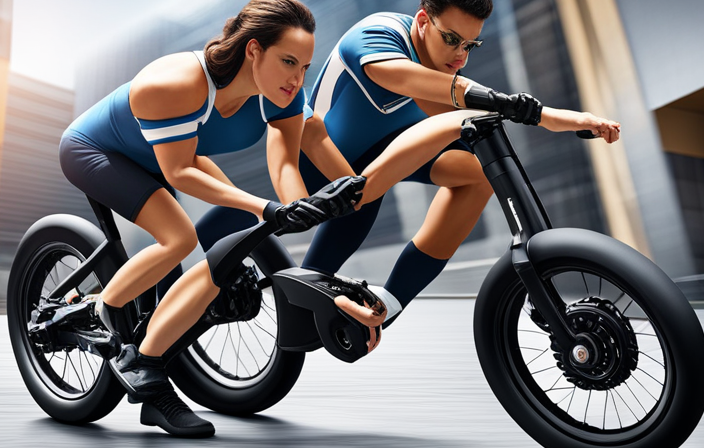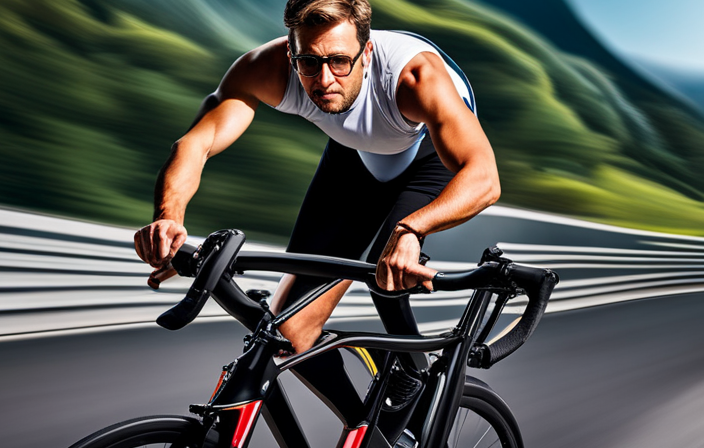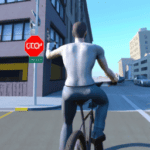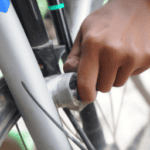When it comes to riding an electric bike, one of the most crucial skills to master is braking. Whether you’re cruising on the open road or navigating through busy city streets, knowing how to brake effectively can make all the difference in your safety and control.
In this article, I’ll guide you through the various types of brakes on electric bikes, share tips for proper hand placement, and teach you the techniques for braking in different riding conditions.
So let’s dive in and learn how to brake like a pro on your electric bike.
Key Takeaways
- Choose the right type of brakes for your electric bike, such as disc brakes for better stopping power and reliability in different weather conditions.
- Maintain proper hand placement and apply brakes gradually to ensure control and react quickly in any situation.
- Modulate braking power and adjust brake pressure for greater control and responsiveness.
- Use appropriate braking techniques for different riding conditions, such as shifting weight on uphill rides and applying brakes evenly and gradually on downhill rides.
Understanding the Types of Brakes on Electric Bikes
Understanding the different types of brakes on electric bikes can help riders make informed decisions about their braking system. When it comes to e-bikes, there are typically two types of brakes: rim brakes and disc brakes.
Rim brakes work by squeezing the brake pads against the rim of the wheel to slow down or stop the bike. They are lightweight and affordable but may not perform as well in wet or muddy conditions.
On the other hand, disc brakes work by squeezing brake pads onto a disc mounted to the wheel hub. They provide better stopping power and are more reliable in different weather conditions.
To ensure effective braking on e-bikes, it is important to practice proper braking techniques for different weather conditions and maintain a good grip on the handlebars.
Transitioning into the next section, proper hand placement for effective braking is essential for safety and control.
Proper Hand Placement for Effective Braking
To ensure effective braking, it’s important to have proper hand placement on the handlebars of an e-bike. Correct hand position is crucial for maintaining control and being able to apply the brakes quickly and efficiently.
The most common braking mistake people make is gripping the handlebars too tightly. This can cause your hands to fatigue quickly and may even lead to hand and arm pain. Instead, you should have a relaxed grip on the handlebars, with your fingers gently wrapped around them.
This allows for better control and reduces the risk of accidentally squeezing the brake levers too hard. By having the correct hand position, you’ll be able to react quickly in any situation and apply the brakes gradually, providing a smoother and safer ride.
Applying the Brakes Gradually
When it comes to effectively using the brakes on an electric bike, there are two key points to remember.
First, squeeze the brake levers gradually. This allows for better control and modulation of the braking force. By doing so, you can prevent sudden jerks or skids that could lead to accidents or injuries.
Second, avoid abrupt stops. This is important for maintaining stability and preventing potential accidents. By gradually reducing your speed instead of slamming on the brakes, you can ride smoothly and safely on your electric bike.
Overall, mastering these techniques will help you ride smoothly and safely on your electric bike.
Squeezing the Brake Levers
Squeezing the brake levers is how you’ll slow down or stop the electric bike. Proper hand placement is crucial for effective braking techniques. Here’s what you need to know:
- Position your hands on the brake levers with your fingers resting on the brake levers themselves.
- Maintain a firm grip on the handlebars while using your index and middle fingers to apply pressure on the brake levers.
- Apply gradual and consistent pressure to the brake levers, avoiding sudden jerks or pulls.
By squeezing the brake levers correctly, you ensure maximum control and stability while slowing down or coming to a complete stop on your electric bike.
Now, let’s delve into the next section on avoiding abrupt stops without compromising safety.
Avoiding Abrupt Stops
By applying gradual and consistent pressure to the brake levers, you can avoid abrupt stops on your e-bike. This not only helps in maintaining control during braking but also prevents sudden halts that can be jarring and unsafe. When you squeeze the brake levers gently and progressively, the bike’s speed decreases smoothly, allowing you to smoothly come to a stop without jerking forward. To help you understand the importance of avoiding abrupt stops, here is a table showcasing the differences between abrupt stops and gradual stops:
| Abrupt Stops | Gradual Stops |
|---|---|
| Uncomfortable | Smooth |
| Unpredictable | Predictable |
| Unsafe | Safe |
| Loss of control | Maintained control |
Now that you understand the benefits of avoiding abrupt stops, let’s move on to the next section about modulating braking power without compromising safety.
Modulating Braking Power
When it comes to modulating braking power on an electric bike, adjusting brake pressure and finding the right balance are crucial.
Adjusting brake pressure allows for greater control and responsiveness, ensuring a smooth and safe braking experience.
Finding the right balance between front and rear brakes is important to prevent skidding or losing control, especially in different road conditions or during emergency stops.
Adjusting Brake Pressure
To adjust the brake pressure on your electric bike, simply use the brake lever.
It’s important to regularly maintain your bike’s brakes to ensure optimal performance and safety.
By adjusting the brake pressure, you can improve brake efficiency and responsiveness.
Start by checking the brake pads for wear and tear. If they are worn down, replace them to maintain proper braking power.
Next, adjust the brake cable tension to ensure smooth and consistent braking. You can do this by loosening or tightening the barrel adjuster located near the brake lever.
Test the brakes after making adjustments to ensure they engage and release properly.
Finding the right balance between too much and too little brake pressure is key to safe and effective braking.
Finding the Right Balance
Achieving the right balance is crucial for safe and effective braking on your e-bike. When it comes to braking, finding the right balance means maintaining control over your bike while slowing down or coming to a stop.
To achieve this, it’s important to distribute your weight evenly between the front and rear brakes. Applying too much pressure on the front brake can cause your bike to pitch forward, while relying solely on the rear brake can result in skidding. By finding the right balance, you can have better control over your bike, allowing you to brake smoothly and safely.
Now that we understand the importance of finding the right balance, let’s explore braking techniques for different riding conditions.
Braking Techniques for Different Riding Conditions
When it comes to braking on different riding conditions, there are a few key points to keep in mind.
First, when braking on uphills, it’s important to shift your weight to the back of the bike to maintain traction on the front wheel.
Second, when braking on downhills, it’s crucial to apply the brakes evenly and gradually to avoid locking up the wheels and losing control.
Lastly, when braking on wet or slippery surfaces, it’s essential to reduce your speed and brake earlier than usual to allow for longer stopping distances.
Braking on Uphills
You’ll want to apply gradual pressure to the brakes when going uphill on an electric bike. Uphill braking technique is crucial to maintaining control and preventing accidents.
When faced with an incline, it’s important to anticipate the need to slow down or stop ahead of time. Begin by shifting to a lower gear to make pedaling easier. As you approach the uphill section, start applying gentle pressure to the brakes to slow down gradually. This will help you maintain stability and prevent the bike from jerking or skidding.
Keep your body balanced and centered while maintaining a steady pedal stroke. By using this technique, you will be able to conquer uphill sections with confidence and control.
Now, let’s move on to the next section about braking on downhills.
Braking on Downhills
As you descend a hill on an e-bike, it’s crucial to maintain control by gently applying pressure to the brakes. Proper braking technique for steep slopes involves a few key elements:
- Body Position: Lean back slightly, keeping your weight centered over the bike, to prevent the front wheel from skidding and maintain stability.
- Brake Modulation: Gradually squeeze the brakes rather than applying them abruptly. This allows for better control and prevents the wheels from locking up.
- Eyes on the Path: Look ahead and choose your line wisely. Anticipate obstacles and adjust your braking accordingly.
By following these techniques, you can navigate downhills with confidence and control. Remember, maintaining proper body position while braking is crucial for a safe and smooth descent.
Now, let’s move on to the next section, where we will discuss braking on wet or slippery surfaces.
Braking on Wet or Slippery Surfaces
Navigating downhills on wet or slippery surfaces can be challenging, but by adjusting your technique and maintaining control, you can safely descend with confidence. When it comes to braking on these conditions, it is crucial to understand the importance of tire traction. The table below summarizes the different braking techniques you can use to maximize traction and ensure a safe descent:
| Braking Technique | Description | Advantages |
|---|---|---|
| Feathering | Applying gentle pressure on the brakes to avoid skidding | Maintains tire traction |
| Modulating | Gradually increasing and decreasing brake pressure | Prevents sudden stops and skidding |
| Trail Braking | Applying rear brake first, then front brake | Provides better stability and control |
Anticipating and Reacting to Potential Hazards
When it comes to riding a bike, being aware of your surroundings is crucial for your safety. This includes scanning the road ahead to identify any potential hazards or obstacles that may require quick reactions.
Additionally, maintaining a safe distance from other vehicles and objects on the road is essential to give yourself enough time to react and avoid collisions.
Lastly, unexpected obstacles can pop up at any moment, so knowing how to react quickly and effectively is key to staying safe while riding.
Scanning the Road Ahead
Look out for any potential obstacles or hazards on the road ahead while riding your electric bike. It’s important to stay alert and be prepared to react to any unexpected hazards that may come your way.
Here are a few tips to help you navigate the road ahead safely:
-
Keep your eyes on the road and scan for any potential hazards such as potholes, debris, or parked cars.
-
Maintain a consistent speed to give yourself enough time to react to any sudden obstacles.
-
Be aware of your surroundings and anticipate the actions of other road users, such as pedestrians or vehicles.
-
Use your brakes judiciously to slow down or stop when necessary, but avoid abrupt braking that can result in loss of control.
-
Stay focused and avoid distractions such as using your phone or listening to music while riding.
Maintaining a Safe Distance
Make sure to keep a safe distance between yourself and other vehicles on the road to reduce the risk of collisions while riding your electric bike. Maintaining a safe distance is crucial, especially in traffic situations where sudden braking may be necessary. By leaving enough space between you and the vehicle in front of you, you allow yourself enough time to react and brake safely.
It’s important to be aware of your surroundings and anticipate any potential hazards. When riding in traffic, I always make sure to have a clear line of sight and maintain a distance of at least a few car lengths from the vehicle in front of me. This gives me enough time to react to any unexpected obstacles that may appear on the road, such as potholes or pedestrians crossing.
Transitioning into the next section, reacting to unexpected obstacles is just as important as maintaining a safe distance.
Reacting to Unexpected Obstacles
It’s crucial to be prepared for unexpected obstacles while riding your electric bike, as reacting quickly can help prevent accidents. When faced with sudden obstacles, such as pedestrians crossing the road or cars abruptly stopping, it’s important to stay calm and act swiftly. One effective way to react is by using proper braking techniques. Braking in crowded areas requires finesse and control to avoid collisions. By modulating the brakes gently, you can slow down or stop your electric bike without skidding or losing control. Here is a table outlining the steps for reacting to sudden obstacles and braking in crowded areas:
| Reacting to Sudden Obstacles | Braking in Crowded Areas |
|---|---|
| Stay calm and focused | Modulate the brakes gently |
| Assess the situation quickly | Maintain a safe distance from other vehicles |
| Plan your course of action | Be aware of your surroundings |
Maintaining and Inspecting Your Brakes
When it comes to maintaining and inspecting your brakes, there are a few key points to keep in mind.
First, regular cleaning and lubrication is essential to keep your brakes working smoothly and efficiently.
Second, it’s important to regularly check your brake pads and rotors for wear and tear, as well as any signs of damage.
And finally, adjusting brake tension is another crucial step in ensuring your brakes are in optimal condition, as it affects their responsiveness and effectiveness.
Regular Cleaning and Lubrication
Regular cleaning and lubrication are important for keeping the electric bike’s braking system in optimal condition. Here are three key reasons why proper lubrication techniques and regular maintenance are important:
-
Prevents rust and corrosion: Over time, moisture and dirt can build up on the brake components, leading to rust and corrosion. Regular cleaning and lubrication create a protective barrier, keeping the brake system in top shape.
-
Ensures smooth operation: Lubricating the moving parts of the brake system, such as the calipers and levers, reduces friction and ensures smooth operation. This results in better braking performance and a more responsive ride.
-
Extends the lifespan of components: Regular maintenance, including cleaning and lubrication, helps extend the lifespan of the brake pads, rotors, and other brake components. By reducing wear and tear, you can save money on replacements and enjoy a safer biking experience.
Checking Brake Pads and Rotors
To ensure optimal performance, you should regularly inspect the brake pads and rotors on your electric bike. Checking brake pad wear is crucial in maintaining safe and efficient braking. Start by visually examining the brake pads for any signs of excessive wear, such as thinning or uneven surfaces. If the brake pads have worn down to the wear indicator line or less, it’s time to replace them.
Next, inspecting rotor alignment is essential. Spin the wheel and observe if the rotor rubs against the brake pads. If there is any rubbing or misalignment, you may need to adjust the rotor or consult a professional for assistance.
By regularly checking brake pad wear and inspecting rotor alignment, you can ensure your electric bike’s brakes are in top condition.
This leads us to the next section on adjusting brake tension.
Adjusting Brake Tension
One way to improve brake performance is by adjusting the tension. Properly adjusted brake tension ensures that the brake pads engage with the wheel rim or disc properly, allowing for effective stopping power.
Here are some key steps to adjust brake tension:
- Start by checking the brake caliper to ensure it is centered and aligned properly.
- Locate the adjusting barrel on the brake cable and loosen it to create more tension or tighten it to reduce tension.
- Test the brakes by squeezing the brake lever and adjusting the tension until the desired braking feel is achieved.
- Finally, make sure to secure the adjusting barrel in place to prevent it from moving during rides.
By adjusting the brake tension correctly, you can optimize your electric bike’s braking performance and have better control over your ride.
Understanding regenerative braking is another important aspect of braking on an electric bike.
Understanding Regenerative Braking
Understanding regenerative braking is crucial for maximizing the efficiency of your electric bike. This innovative braking system harnesses the energy generated during braking and converts it into usable power, which is then stored in the battery for later use.
Regenerative braking not only helps to extend the range of your electric bike by reducing energy consumption, but it also offers other benefits. Firstly, regenerative braking increases the lifespan of your brake pads and reduces wear and tear on your bike’s mechanical components. Secondly, it provides a smoother and more controlled braking experience, allowing for better stability and control. Lastly, regenerative braking contributes to a more sustainable and eco-friendly mode of transportation.
Now that we understand the benefits of regenerative braking, let’s move on to practicing emergency braking maneuvers.
Practicing Emergency Braking Maneuvers
When it comes to emergency situations while riding a bike, being prepared and knowing how to react can make all the difference.
In this discussion, I will cover two important maneuvers: emergency stops and emergency swerving.
Emergency stops involve quickly and safely coming to a halt, while emergency swerving requires the ability to change direction abruptly to avoid obstacles.
Mastering these techniques can help cyclists stay safe on the road and react effectively in unexpected situations.
Emergency Stops
To perform an emergency stop on your electric bike, quickly squeeze both the front and rear brakes while maintaining a firm grip on the handlebars. This technique is crucial for ensuring your safety and preventing accidents. Here are some important tips to keep in mind when it comes to emergency braking techniques and preventing skidding during emergency stops:
- Keep your weight centered over the bike to maintain balance and control.
- Gradually increase the pressure on the brakes rather than slamming them on abruptly.
- Look ahead and anticipate any obstacles or hazards to give yourself enough time to react and stop safely.
- Practice emergency stops in a controlled environment to familiarize yourself with the bike’s braking capabilities.
By mastering emergency stops, you’ll be better prepared to handle unexpected situations on the road.
Now, let’s move on to the next essential skill: emergency swerving, which can help you avoid obstacles when stopping isn’t an option.
Emergency Swerving
Now, let’s focus on how you can effectively swerve to avoid obstacles in emergency situations.
When it comes to emergency braking techniques, avoiding skidding is crucial. In order to swerve safely, it’s important to maintain control of your electric bike while making quick maneuvers.
Start by shifting your body weight towards the direction you want to swerve, and keep your eyes focused on the path you intend to take. Gradually apply the brakes while steering smoothly in the desired direction.
Be careful not to jerk the handlebars or brake too abruptly, as this could lead to loss of control or a potential skid. By executing these emergency swerving techniques with precision and keeping calm, you can effectively navigate around obstacles and ensure your safety on the road.
Speaking of safety, let’s now move on to the next section which will provide tips for braking on different electric bike models.
Tips for Braking on Different Electric Bike Models
When it comes to choosing a bike, there are various options available to suit different needs and preferences.
Road bikes are designed for speed and are perfect for those who enjoy cycling on smooth pavements or participating in races.
Mountain bikes, on the other hand, are built for off-road adventures, with features like suspension and wider tires to handle rough terrains.
Lastly, folding bikes are ideal for those who need a compact and portable option, as they can be easily folded and stored in small spaces.
Each type of bike has its own advantages and it’s important to consider your intended use before making a decision.
Road Bikes
If you’re riding a road bike, remember to apply gentle pressure to the brake levers to slow down smoothly. This is important for both safety and braking efficiency. Here are some tips to help you optimize your braking experience on a road bike:
-
Position your hands correctly on the brake levers. Make sure your fingers are resting comfortably on the levers, allowing for easy access to apply the brakes when needed.
-
Use both brakes simultaneously. By using both the front and rear brakes together, you distribute the braking force evenly, preventing skidding and ensuring stability.
-
Modulate the pressure on the levers. Gradually increase the pressure as you need to slow down or come to a stop. This will help prevent sudden jolts and reduce the risk of hand fatigue.
-
Anticipate your braking needs. Keep an eye on the road ahead and anticipate any obstacles or changes in traffic. By planning ahead, you can brake more smoothly and efficiently.
Transitioning into the subsequent section about mountain bikes, it’s important to note that the braking techniques for road bikes differ from those for mountain bikes.
Mountain Bikes
As I ride a mountain bike, I always remember to adjust my body position to maintain balance and control on rough terrain. Mountain biking techniques are crucial in navigating through challenging trails.
One important aspect to consider is choosing the right braking system. There are two main types: rim brakes and disc brakes. Rim brakes use pads that grip the wheel rims to slow down or stop. They are lightweight and inexpensive, but may not perform as well in wet or muddy conditions.
On the other hand, disc brakes provide powerful stopping force and work well in all weather conditions. They come in two variations: mechanical and hydraulic disc brakes. Mechanical disc brakes are easier to maintain, while hydraulic disc brakes offer more precise modulation.
With the right braking system, I can confidently tackle any mountain biking adventure.
Speaking of bikes, let’s now transition to the subsequent section about folding bikes.
Folding Bikes
Folding bikes are convenient for commuters who need a portable mode of transportation. These compact bicycles offer several advantages over traditional bikes. Not only are they lightweight and easy to carry, but they can also be folded and stored in small spaces like closets or under desks. Additionally, folding bikes are allowed on many forms of public transportation, making it easier to combine cycling with other modes of travel.
One of the key advantages of folding bikes is their low maintenance requirements. With proper care and regular maintenance, these bikes can last for many years. It is important to keep the folding mechanisms clean and lubricated to ensure smooth operation. Regularly inspecting and tightening bolts and screws is also essential to prevent any loose parts. Additionally, it is recommended to periodically check the tires for proper inflation and wear, and to clean the bike after riding in wet or dirty conditions to prevent corrosion.
To summarize, folding bikes are a convenient and practical option for commuters. Their portability and low maintenance requirements make them an excellent choice for those who need a reliable mode of transportation. By following proper folding bike maintenance practices, these bikes can provide many years of reliable service.
| Advantages of Folding Bikes | Maintenance Tips |
|---|---|
| Portability | Keep folding mechanisms clean and lubricated |
| Easy storage | Regularly inspect and tighten bolts and screws |
| Allowed on public transport | Check tires for proper inflation and wear |
Frequently Asked Questions
Can I use the same braking technique on all types of electric bikes?
Yes, the same braking technique can be used on all types of electric bikes. However, it’s important to note that there may be slight differences in braking performance and responsiveness between different electric bike models.
How often should I inspect and maintain my electric bike brakes?
I inspect and maintain my electric bike brakes regularly. I check the brake pads for wear and tear and replace them if necessary. I also inspect and lubricate the brake cables to ensure smooth operation.
Are there any specific safety measures to consider while braking on wet or slippery surfaces?
When braking on wet or slippery surfaces, it is crucial to adapt your braking techniques for maximum safety. Maintaining traction control becomes even more important to prevent skidding or losing control of the electric bike.
Can regenerative braking be used as the primary braking method on electric bikes?
Regenerative braking can be used as the primary braking method on electric bikes, but it’s important to consider its efficiency compared to traditional braking. Regenerative braking converts kinetic energy into electrical energy to recharge the battery, but it may not provide the same level of stopping power as traditional braking.
What should I do if I experience brake failure while riding my electric bike?
If I experience brake failure while riding my electric bike, I would first try emergency braking techniques like using the rear brake or dragging my feet. If that fails, I would troubleshoot common brake issues like checking for loose cables or worn brake pads.
Conclusion
In conclusion, mastering the art of braking on an electric bike is crucial for both safety and performance. By understanding the different types of brakes and practicing proper hand placement, you can ensure effective braking in any situation.
Remember to apply the brakes gradually and modulate the braking power to avoid skidding or loss of control. Additionally, familiarize yourself with different braking techniques for various riding conditions and regularly maintain and inspect your brakes for optimal performance.
So, why wait? Start honing your braking skills today and enjoy a smoother and safer ride on your electric bike.
















